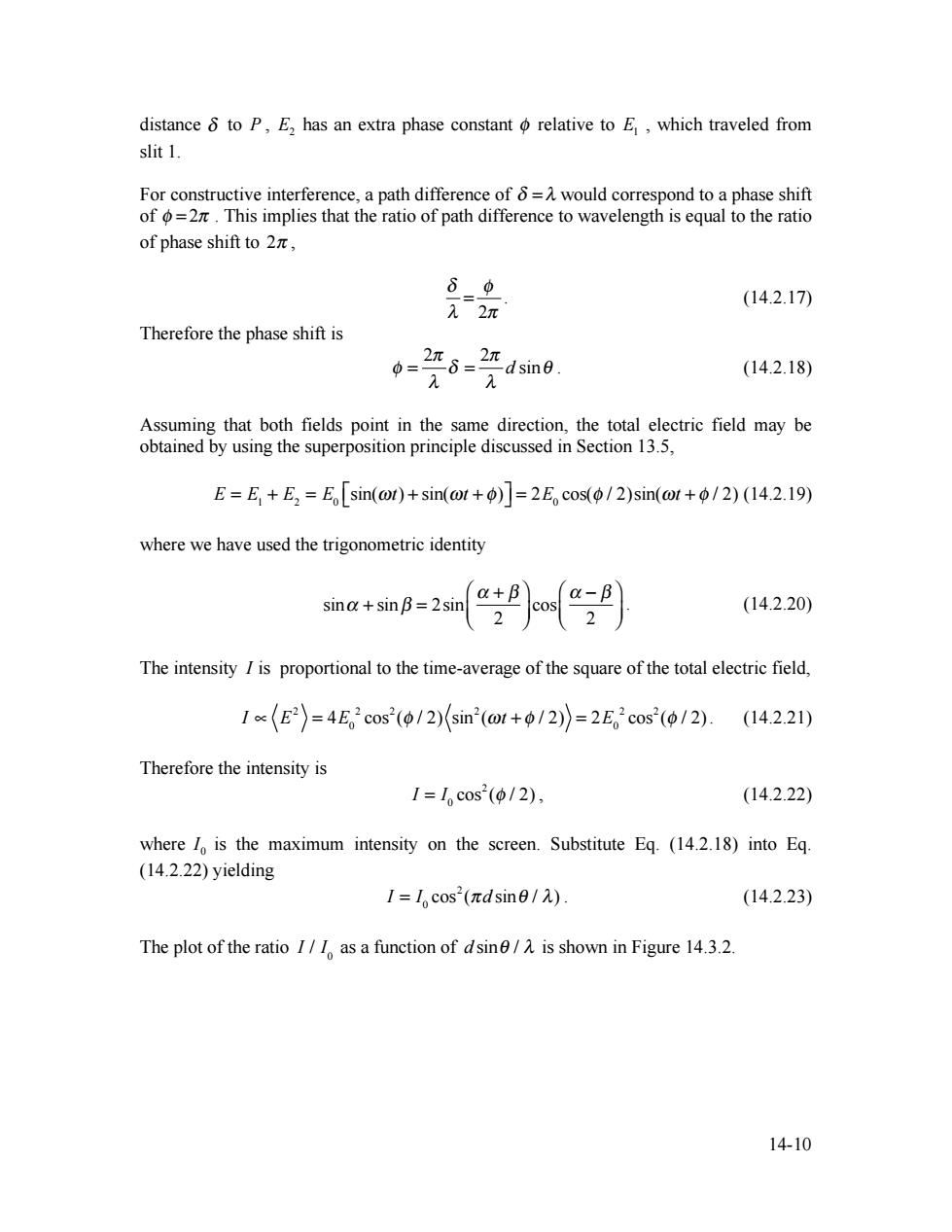正在加载图片...

distance 8 to P,E2 has an extra phase constant o relative to E,which traveled from slit 1. For constructive interference,a path difference of 8=A would correspond to a phase shift of o=2.This implies that the ratio of path difference to wavelength is equal to the ratio of phase shift to2π, 60 (14.2.17) 12π Therefore the phase shift is 0= 61 dsine. (14.2.18) Assuming that both fields point in the same direction,the total electric field may be obtained by using the superposition principle discussed in Section 13.5, E=E+E2=E[sin(@t)+sin(@t+)=2E cos(/2)sin(t+/2)(14.2.19) where we have used the trigonometric identity sina+sinB=2sin m (14.2.20) The intensity I is proportional to the time-average of the square of the total electric field, I(E2)=4E2cos(/2)(sin(@t+/2)=2Ecos(/2). (14.2.21) Therefore the intensity is 1=1cos2(0/2), (14.2.22) where /o is the maximum intensity on the screen.Substitute Eq.(14.2.18)into Eq. (14.2.22)yielding I=Icos(πdsin6/) (14.2.23) The plot of the ratio I/I as a function of dsine/A is shown in Figure 14.3.2. 14-1014-10 distance δ to P , E2 has an extra phase constant φ relative to E1 , which traveled from slit 1. For constructive interference, a path difference of δ = λ would correspond to a phase shift of φ = 2π . This implies that the ratio of path difference to wavelength is equal to the ratio of phase shift to 2π , 2 δ φ λ π = . (14.2.17) Therefore the phase shift is 2 2 d sin π π φ δ θ λ λ = = . (14.2.18) Assuming that both fields point in the same direction, the total electric field may be obtained by using the superposition principle discussed in Section 13.5, E = E1 + E2 = E0 ⎡sin(ωt) + sin(ωt + φ) ⎣ ⎤ ⎦ = 2E0 cos(φ / 2)sin(ωt + φ / 2) (14.2.19) where we have used the trigonometric identity sinα + sinβ = 2sin α + β 2 ⎛ ⎝ ⎜ ⎞ ⎠ ⎟ cos α − β 2 ⎛ ⎝ ⎜ ⎞ ⎠ ⎟ . (14.2.20) The intensity I is proportional to the time-average of the square of the total electric field, I ∝ E2 = 4E0 2 cos2 (φ / 2) sin2 (ωt + φ / 2) = 2E0 2 cos2 (φ / 2). (14.2.21) Therefore the intensity is I = I0 cos2 (φ / 2) , (14.2.22) where 0 I is the maximum intensity on the screen. Substitute Eq. (14.2.18) into Eq. (14.2.22) yielding I = I0 cos2 (πd sinθ / λ) . (14.2.23) The plot of the ratio I / I0 as a function of d sinθ / λ is shown in Figure 14.3.2